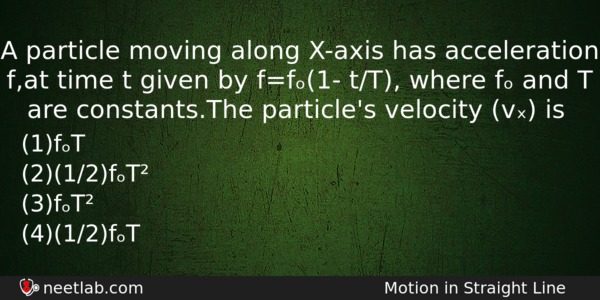| ⇦ | 
| ⇨ |
A particle moving along X-axis has acceleration f,at time t given by f=fₒ(1- t/T), where fₒ and T are constants. The particle’s velocity (vₓ) is
Options
(a) fₒT
(b) (1/2)fₒT²
(c) fₒT²
(d) (1/2)fₒT
Correct Answer:
(1/2)fₒT
Explanation:
Acceleration, f = dv/dt = f₀[1-(t/T)]
dv = f₀[1-(t/T)]dt —–(i)
On integrating Equation (i) both sides, we get
.·. v = f₀t – (f₀/T)(t²/2)dt + C —–(ii)
After applying boundery conditions v = 0 at t = 0, we get
Therefore, C = 0
v = f₀t – (f₀/T)(t²/2)dt —–(iii)
As, f = f₀[1-(t/T)]
When, f = 0,t = T
Substituting, t = T in Equation (iii), then velocity
vₓ = f₀T – (f₀/T)(T²/2)
= f₀T – (1/2)f₀T = (1/2)fₒT
Related Questions: - Two capacitors of capacitances 2 μF and 3 μF are joined in series.
- Two metal wires of identical dimensions are connected in series. If σ₁ and σ₂ are
- Magnetism of a magnet is due to
- Consider 3rd orbit of He⁺(helium), using non-relativistic approach, the speed
- A body is thrown vertically upward in air when air resistance is taken into account
Topics: Motion in Straight Line
(93)
Subject: Physics
(2479)
Important MCQs Based on Medical Entrance Examinations To Improve Your NEET Score
- Two capacitors of capacitances 2 μF and 3 μF are joined in series.
- Two metal wires of identical dimensions are connected in series. If σ₁ and σ₂ are
- Magnetism of a magnet is due to
- Consider 3rd orbit of He⁺(helium), using non-relativistic approach, the speed
- A body is thrown vertically upward in air when air resistance is taken into account
Topics: Motion in Straight Line (93)
Subject: Physics (2479)
Important MCQs Based on Medical Entrance Examinations To Improve Your NEET Score
18000+ students are using NEETLab to improve their score. What about you?
Solve Previous Year MCQs, Mock Tests, Topicwise Practice Tests, Identify Weak Topics, Formula Flash cards and much more is available in NEETLab Android App to improve your NEET score.
Share this page with your friends

Leave a Reply